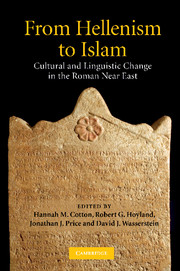Book contents
- Frontmatter
- Contents
- List of figures
- List of tables
- List of contributors
- Preface
- List of abbreviations
- Introduction: documentary evidence, social realities and the history of language
- Part I THE LANGUAGE OF POWER: LATIN IN THE ROMAN NEAR EAST
- Part II SOCIAL AND LEGAL INSTITUTIONS AS REFLECTED IN THE DOCUMENTARY EVIDENCE
- 3 Euergetism in Josephus and the epigraphic culture of first-century Jerusalem
- 4 Legal and social status of threptoi and related categories in narrative and documentary sources
- 5 Ritual performances of divine justice: the epigraphy of confession, atonement, and exaltation in Roman Asia Minor
- 6 Continuity of Nabataean law in the Petra papyri: a methodological exercise
- Part III THE EPIGRAPHIC LANGUAGE OF RELIGION
- Part IV LINGUISTIC METAMORPHOSES AND CONTINUITY OF CULTURES
- Part V GREEK INTO ARABIC
- Index
6 - Continuity of Nabataean law in the Petra papyri: a methodological exercise
Published online by Cambridge University Press: 01 March 2010
- Frontmatter
- Contents
- List of figures
- List of tables
- List of contributors
- Preface
- List of abbreviations
- Introduction: documentary evidence, social realities and the history of language
- Part I THE LANGUAGE OF POWER: LATIN IN THE ROMAN NEAR EAST
- Part II SOCIAL AND LEGAL INSTITUTIONS AS REFLECTED IN THE DOCUMENTARY EVIDENCE
- 3 Euergetism in Josephus and the epigraphic culture of first-century Jerusalem
- 4 Legal and social status of threptoi and related categories in narrative and documentary sources
- 5 Ritual performances of divine justice: the epigraphy of confession, atonement, and exaltation in Roman Asia Minor
- 6 Continuity of Nabataean law in the Petra papyri: a methodological exercise
- Part III THE EPIGRAPHIC LANGUAGE OF RELIGION
- Part IV LINGUISTIC METAMORPHOSES AND CONTINUITY OF CULTURES
- Part V GREEK INTO ARABIC
- Index
Summary
What do we know of Nabataean law? Or, rather, what are our sources for Nabataean law?
Although some legal customs can be inferred and gleaned from literary sources about the Nabataeans, most, if not all, the evidence derives from documentary texts, inscriptions and papyri, written in the Nabataean script in Nabataean Aramaic (and as will become clear later on, also in Greek). This documentary evidence, to use John Healey's phrase, ‘is not “supported”, so to speak, by the survival of any contemporary or later literature in Nabataean’. ‘Unsupported’ is indeed an understatement: in contrast to Roman or Jewish law for example, a vacuum exists outside the documents whose testimony cannot be enhanced, modified, explained or nuanced by a body of literary legal tradition. In this Nabataean shares the fate of several other Near Eastern Semitic languages represented by epigraphic documents alone. On the other hand, the Nabataean legal document in the Nabataean script is part of the ‘Aramaic common law tradition’, and its formulae and provisions can be profi tably compared and contrasted with sibling documents. My aim in the present exercise, however, is not to detect identity, similarity and continuity of formulae, not even ‘to identify the diversity existing within commonality’ of ‘heirs to a rich Aramaic tradition,’ but rather to isolate pieces of substantive Nabataean law, more precisely the Nabataean law of persons. Paradoxically as it may seem at first sight, my task was rendered easier by the fact that I rely on documents written mostly in Greek rather than in Nabataean Aramaic.
- Type
- Chapter
- Information
- From Hellenism to IslamCultural and Linguistic Change in the Roman Near East, pp. 154 - 174Publisher: Cambridge University PressPrint publication year: 2009
- 4
- Cited by

